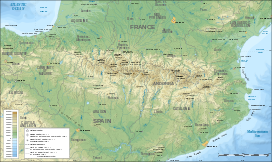Aneto
| Aneto | |
|---|---|

North face of Aneto
|
|
| Highest point | |
| Elevation | 3,404 m (11,168 ft) |
| Prominence | 2,812 m (9,226 ft) Ranked 123rd |
| Isolation | 514 kilometres (319 mi) |
| Listing | List of mountains in Aragon, Ultra |
| Coordinates | 42°37′56″N 00°39′28″E / 42.63222°N 0.65778°ECoordinates: 42°37′56″N 00°39′28″E / 42.63222°N 0.65778°E |
| Geography | |
| Location | Ribagorza, Aragon, Spain |
| Parent range | Pyrenees |
| Climbing | |
| First ascent | July 20, 1842 |
| Easiest route | basic snow/ice climb |
Aneto is the highest mountain in the Pyrenees and in Aragon, and Spain's third-highest mountain, reaching a height of 3,404 metres (11,168 ft). It stands in the Spanish province of Huesca, the northernmost of all three Aragonese provinces, 4 miles south of the French border. It forms the southernmost part of the Maladeta massif. It is also still locally known as Pic de Néthou in French, that name and its variants having been in general use until the beginning of the 20th century.
Aneto is located in the Posets-Maladeta Natural Park, in the municipality of Benasque, Huesca province, autonomous community of Aragon, Spain. It is part of the Maladeta massif and is located in the Benasque valley. It consists of Paleozoic terrain of a granitic nature and Mesozoic materials. Its northern side holds the largest glacier in the Pyrenees, covering 79.6 hectares (197 acres) in 2005; it is shrinking rapidly due to warming summer temperatures and decreasing winter precipitations over the 20th century – it covered 106.7 ha in 1981, and over 200 ha in the 19th century. It is estimated that it has lost more than half of its surface in the last 100 years, and that it may disappear around 2050.
Initially, the great mass of granite did not even have a name. There are indications that the shepherds and hunters from the southern valleys referred to it as Malheta or Malahita or Punta. The first cultured traveller who saw it from the port (or pass) of Benasque, Louis Ramond de Carbonnières, simply described its appearance as "needles of ice" in 1787.
The highest point of the Pyrenees eventually inherited the name of a village on its south-eastern side: Aneto. The French, on hearing the Argonese pronunciation of "Aneto", retained the last two clearly accentuated phonetic syllables, "ne" and "tu", ignoring the first syllable "a". Based on such oral transcription, the French name "Netou" came to exist along with several historical variants: Nelto, Nettou, Anetthou, Annetton, Anelthou, Nethom or Aréthon, all used by various cartographers. Even though the summit and slopes are entirely within Spanish territory, the first extensive studies of the Pyrenees - and the only ones for the following 100 years - were French ones from the 19th century - starting with the very detailed study by Jean Daniel François Schrader (1844-1924) in 1874. So these names were the toponyms that were then used. It took Émile Belloc's renown work on the Pyrenees (notably its hydrology, glaciology and etymology) to establish the name of Aneto as the official toponym; he consistently used that name in 1898 already.
...
Wikipedia

